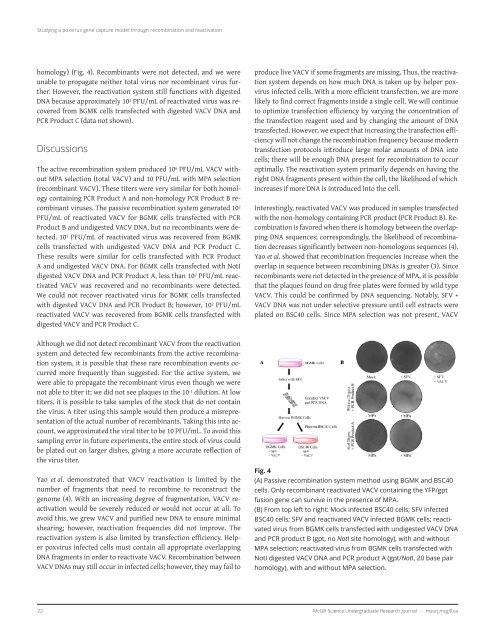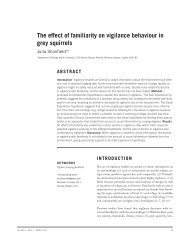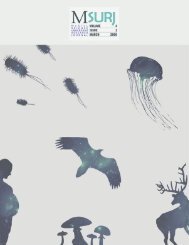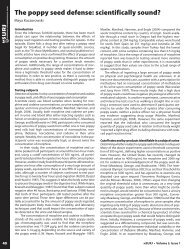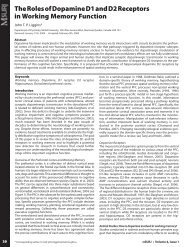the entire issue - McGill Science Undergraduate Research Journal ...
the entire issue - McGill Science Undergraduate Research Journal ...
the entire issue - McGill Science Undergraduate Research Journal ...
Create successful ePaper yourself
Turn your PDF publications into a flip-book with our unique Google optimized e-Paper software.
Studying a poxvirus gene capture model through recombination and reactivation<br />
homology) (Fig. 4). Recombinants were not detected, and we were<br />
unable to propagate nei<strong>the</strong>r total virus nor recombinant virus fur<strong>the</strong>r.<br />
However, <strong>the</strong> reactivation system still functions with digested<br />
DNA because approximately 10 2 PFU/mL of reactivated virus was recovered<br />
from BGMK cells transfected with digested VACV DNA and<br />
PCR Product C (data not shown).<br />
Discussions<br />
The active recombination system produced 10 6 PFU/mL VACV without<br />
MPA selection (total VACV) and 10 PFU/mL with MPA selection<br />
(recombinant VACV). These titers were very similar for both homology<br />
containing PCR Product A and non-homology PCR Product B recombinant<br />
viruses. The passive recombination system generated 10 2<br />
PFU/mL of reactivated VACV for BGMK cells transfected with PCR<br />
Product B and undigested VACV DNA, but no recombinants were detected.<br />
10 5 PFU/mL of reactivated virus was recovered from BGMK<br />
cells transfected with undigested VACV DNA and PCR Product C.<br />
These results were similar for cells transfected with PCR Product<br />
A and undigested VACV DNA. For BGMK cells transfected with NotI<br />
digested VACV DNA and PCR Product A, less than 10 2 PFU/mL reactivated<br />
VACV was recovered and no recombinants were detected.<br />
We could not recover reactivated virus for BGMK cells transfected<br />
with digested VACV DNA and PCR Product B; however, 10 2 PFU/mL<br />
reactivated VACV was recovered from BGMK cells transfected with<br />
digested VACV and PCR Product C.<br />
Although we did not detect recombinant VACV from <strong>the</strong> reactivation<br />
system and detected few recombinants from <strong>the</strong> active recombination<br />
system, it is possible that <strong>the</strong>se rare recombination events occurred<br />
more frequently than suggested. For <strong>the</strong> active system, we<br />
were able to propagate <strong>the</strong> recombinant virus even though we were<br />
not able to titer it; we did not see plaques in <strong>the</strong> 10 -1 dilution. At low<br />
titers, it is possible to take samples of <strong>the</strong> stock that do not contain<br />
<strong>the</strong> virus. A titer using this sample would <strong>the</strong>n produce a misrepresentation<br />
of <strong>the</strong> actual number of recombinants. Taking this into account,<br />
we approximated <strong>the</strong> viral titer to be 10 PFU/mL. To avoid this<br />
sampling error in future experiments, <strong>the</strong> <strong>entire</strong> stock of virus could<br />
be plated out on larger dishes, giving a more accurate reflection of<br />
<strong>the</strong> virus titer.<br />
Yao et al. demonstrated that VACV reactivation is limited by <strong>the</strong><br />
number of fragments that need to recombine to reconstruct <strong>the</strong><br />
genome (4). With an increasing degree of fragmentation, VACV reactivation<br />
would be severely reduced or would not occur at all. To<br />
avoid this, we grew VACV and purified new DNA to ensure minimal<br />
shearing; however, reactivation frequencies did not improve. The<br />
reactivation system is also limited by transfection efficiency. Helper<br />
poxvirus infected cells must contain all appropriate overlapping<br />
DNA fragments in order to reactivate VACV. Recombination between<br />
VACV DNAs may still occur in infected cells; however, <strong>the</strong>y may fail to<br />
produce live VACV if some fragments are missing. Thus, <strong>the</strong> reactivation<br />
system depends on how much DNA is taken up by helper poxvirus<br />
infected cells. With a more efficient transfection, we are more<br />
likely to find correct fragments inside a single cell. We will continue<br />
to optimize transfection efficiency by varying <strong>the</strong> concentration of<br />
<strong>the</strong> transfection reagent used and by changing <strong>the</strong> amount of DNA<br />
transfected. However, we expect that increasing <strong>the</strong> transfection efficiency<br />
will not change <strong>the</strong> recombination frequency because modern<br />
transfection protocols introduce large molar amounts of DNA into<br />
cells; <strong>the</strong>re will be enough DNA present for recombination to occur<br />
optimally. The reactivation system primarily depends on having <strong>the</strong><br />
right DNA fragments present within <strong>the</strong> cell, <strong>the</strong> likelihood of which<br />
increases if more DNA is introduced into <strong>the</strong> cell.<br />
Interestingly, reactivated VACV was produced in samples transfected<br />
with <strong>the</strong> non-homology containing PCR product (PCR Product B). Recombination<br />
is favored when <strong>the</strong>re is homology between <strong>the</strong> overlapping<br />
DNA sequences; correspondingly, <strong>the</strong> likelihood of recombination<br />
decreases significantly between non-homologous sequences (4).<br />
Yao et al. showed that recombination frequencies increase when <strong>the</strong><br />
overlap in sequence between recombining DNAs is greater (3). Since<br />
recombinants were not detected in <strong>the</strong> presence of MPA, it is possible<br />
that <strong>the</strong> plaques found on drug free plates were formed by wild type<br />
VACV. This could be confirmed by DNA sequencing. Notably, SFV +<br />
VACV DNA was not under selective pressure until cell extracts were<br />
plated on BSC40 cells. Since MPA selection was not present, VACV<br />
Fig. 4<br />
(A) Passive recombination system method using BGMK and BSC40<br />
cells. Only recombinant reactivated VACV containing <strong>the</strong> YFP/gpt<br />
fusion gene can survive in <strong>the</strong> presence of MPA.<br />
(B) From top left to right: Mock infected BSC40 cells; SFV infected<br />
BSC40 cells; SFV and reactivated VACV infected BGMK cells; reactivated<br />
virus from BGMK cells transfected with undigested VACV DNA<br />
and PCR product B (gpt, no NotI site homology), with and without<br />
MPA selection; reactivated virus from BGMK cells transfected with<br />
NotI digested VACV DNA and PCR product A (gpt/NotI, 20 base pair<br />
homology), with and without MPA selection.<br />
22<br />
<strong>McGill</strong> <strong>Science</strong> <strong>Undergraduate</strong> <strong>Research</strong> <strong>Journal</strong> - msurj.mcgill.ca


